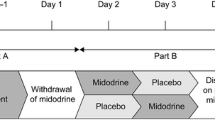Abstract
To explore whether oral rehydration salts (ORS) is effective in the treatment of children with vasovagal syncope (VVS). One hundred and sixty-six consecutive patients with recurrent syncope and positive head-up tilt testing (HUTT) were recruited, randomly divided to conventional therapy (health education and tilt training) plus ORS (with 500 ml of water) group (Group I, 87 patients) and conventional therapy group (Group II, 79 patients). Therapeutic effect was evaluated by changes of syncopal episode and reperformed HUTT response. At the end of 6-month follow-up, syncopal episode did not reoccur in 49 (56.3 %) patients, decreased in 34 (39.1 %) patients, and had no obvious change or increased in four (4.6 %) patients in Group I, and the results were 31 (39.2 %), 37 (46.8 %), and 11 (14 %) in Group II, respectively. The difference was significant (χ 2 = 7.074, P < 0.05). When HUTT was reperformed, 57 (65.5 %) and 28 (35.4 %) patients had negative response and 30 (34.5 %) and 51 (64.6 %) patients had positive response, respectively, in Group I and Group II. The difference was also significant (χ 2 = 13.808, P < 0.01). In Group I, the two aspects had no difference between vasodepressor type and mixed type; however, syncopal episode had a significant difference between children aged ≤12 and >12 years (χ 2 = 6.371, P < 0.05); there was no difference in reperformed HUTT response. ORS with 500 ml of water is an effective therapy for VVS. It can be recommended as one of non- pharmacological treatment measures in children with VVS.
Similar content being viewed by others
References
Bellard E, Fortrat JO, Custaud MA, Victor J, Greenleaf J, Lefthériotis G (2007) Increased hydration alone does not improve orthostatic tolerance in patients with neurocardiogenic syncope. Clin Auton Res 17(2):99–105
Boedtkjer E, Aalkjaer C (2012) Intracellular pH in the resistance vasculature: regulation and functional implications. J Vasc Res 49(6):479–496. doi:10.1159/000341235
Chen L, Du JB, Zhang QY et al (2007) A multicenter study on treatment of autonomous nerve-mediated syncope in children with beta-receptor blocker. Zhonghua Er Ke Za Zhi 45(12):885–888
Chu W, Wang C, Lin P, Li F, Wu L, Xie Z (2014) Transient aphasia: a rare complication of head-up tilt test. Neurol Sci 35(7):1127–1132. doi:10.1007/s10072-014-1664-1
Cooper VL, Hainsworth R (2002) Effects of dietary salt on orthostatic tolerance, blood pressure and baroreceptor sensitivity in patients with syncope. Clin Auton Res 12(4):236–241
Crimi E, Taccone FS, Infante T, Scolletta S, Crudele V, Napoli C (2012) Effects of intracellular acidosis on endothelial function: an overview. J Crit Care 27(2):108–118. doi:10.1016/j.jcrc.2011.06.001
Driscoll DJ, Jacobsen SJ, Porter CJ, Wollan PC (1997) Syncope in children and adolescents. J Am Coll Cardiol 29(5):1039–1045
El-Sayed H, Hainsworth R (1996) Salt supplement increases plasma volume and orthostatic tolerance in patients with unexplained syncope. Heart 75(2):134–140
Fang Y, Mu JJ, He LC, Wang SC, Liu ZQ (2006) Salt loading on plasma asymmetrical dimethylarginine and the protective role of potassium supplement in normotensive salt-sensitive asians. Hypertension 48(4):724–729
Fenton AM, Hammill SC, Rea RF, Low PA, Shen WK (2000) Vasovagal syncope. Ann Intern Med 133(9):714–725
Fitzpatrick AP, Theodorakis G, Vardas P, Sutton R (1991) Methodology of head-up tilt testing in patients with unexplained syncope. J Am Coll Cardiol 17(1):125–130
Harris JP, Garfunkel LC, Wycoff C et al (1999) Cardiovascular aspects of neurally mediated syncope in adolescents. Pediatr Res 45:4A
He FJ, Marciniak M, Carney C et al (2010) Effects of potassium Chloride and potassium bicarbonate on endothelial function, cardiovascular risk factors, and bone turnover in mild hypertensives. Hypertension 55(3):681–688. doi:10.1161/HYPERTENSIONAHA.109.147488
Kapoor WN (2000) Syncope. N Engl J Med 343(25):1856–1862
Linzer M, Pontinen M, Gold DT, Divine GW, Felder A, Brooks WB (1991) Impairment of physical and psychosocial function in recurrent syncope. J Clin Epidemiol 44(10):1037–1043
McHarg ML, Shinnar S, Rascoff H, Walsh CA (1997) Syncope in childhood. Pediatr Cardiol 18(5):367–371
Moya A, Sutton R, Ammirati F et al (2009) Guidelines for the diagnosis and management of syncope (version 2009). Eur Heart J 30(21):2631–2671. doi:10.1093/eurheartj/ehp298
Mtinangi BL, Hainsworth R (1998) Early effects of oral salt on plasma volume, orthostatic tolerance, and baroreceptor sensitivity in patients with syncope. Clin Auton Res 8(4):231–235
Pilcher TA, Saarel EV (2014) A teenage fainter (dizziness, syncope, postural orthostatic tachycardia syndrome). Pediatr Clin N Am 61(1):29–43. doi:10.1016/j.pcl.2013.09.009
Rose MS, Koshman ML, Spreng S, Sheldon R (2000) The relationship between health-related quality of life and frequency of spells in patients with syncope. J Clin Epidemiol 53(12):1209–1216
Shannon RP, Wei JY, Rosa JY, Epstein FH, Rowe JW (1986) The effect of age and sodium deletion on cardiovascular response to orthostasis. Hypertension 8(5):438–443
Shi DC, Mu JJ, Chen ER et al (2006) Endothelial function evaluation in salt-sensitive normotensive and mild hypertensive subjects and effects of potassium supplement. Zhonghua Xin Xue Guan Bing Za Zhi 34(1):38–41
Wieling W, Colman N, Krediet CT, Freeman R (2004) Nonpharmacological treatment of reflex syncope. Clin Auton Res 14(Suppl 1):62–70
Xu Y, Lin P, Wang C et al (2013) Investigation of 24-hour blood pressure monitoring for evaluating treatment outcome of nerve-mediated syncope in children. Zhongguo Dang Dai Er Ke Za Zhi 15(6):458–461
Younoszai AK, Franklin WH, Chan DP, Cassidy SC, Allen HD (1998) Oral fluid therapy: a promising treatment for vasodepressor syncope. Arch Pediatr Adolesc Med 152(2):165–168
Zhang FW, Liao Y, Li XY, Chen L, Jin HF, Du JB (2011) Therapies for postural tachycardia syndrome in children. Zhonghua Er Ke Za Zhi 49(6):428–432
Acknowledgments
The work was supported by the National Twelfth Five-Year Plan for Science and Technology Support of China (2012BAI03B03), the Natural Science Foundation of Hunan Province of China (13JJ5014).
Conflict of interest
None.
Author information
Authors and Affiliations
Corresponding author
Rights and permissions
About this article
Cite this article
Chu, W., Wang, C., Wu, L. et al. Oral Rehydration Salts: An Effective Choice for the Treatment of Children with Vasovagal Syncope. Pediatr Cardiol 36, 867–872 (2015). https://doi.org/10.1007/s00246-015-1097-5
Received:
Accepted:
Published:
Issue Date:
DOI: https://doi.org/10.1007/s00246-015-1097-5




